The Shenzhen Stock Exchange is China’s second-largest stock exchange and is a force for supporting China’s innovation and financial growth. It’s the platform for emerging industries and innovative enterprises in China. For potential investors, understanding how the SZSE works and its significance is key.
Here, we’ve created a comprehensive guide covering every aspect of the Shenzhen Stock Exchange. We’ll examine everything from its boards, stock data, and regulatory requirements to ESG initiatives and international connectivity.
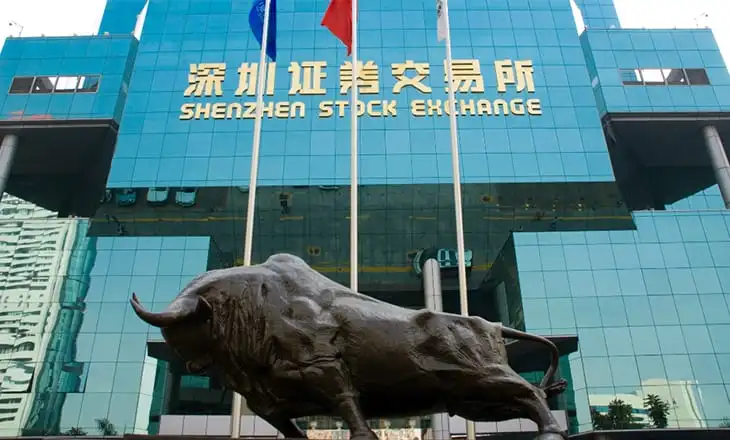
Image Credit: caixinglobal.com
Shenzen Stock Exchange building
TL;DR: Key Takeaways
- The SZSE was developed with the focus of supporting innovative, tech, and high-growth companies.
- The manufacturing sector is a major participant in the SZSE.
- With three different boards, the SZSE provides listing opportunities for a range of companies and enterprises.
- Listing requirements for the SZSE are generally more lenient than with the Shanghai Stock Exchange.
- Regulatory reforms have enhanced overall market stability.
- Expanded global reach and international connectivity are high on the list of priorities for the SZSE.
- ESG continues to have a growing influence on investor behaviors and how they impact the SZSE.
- Tiingo can be your partner in investment strategy, with tools like our IEX API.
The SZSE’s Journey: From Inception to Innovation Hub

Image Credit: Wikimedia
The SZSE is a primary economic hub, focused on growth and innovation.
The Shenzhen Stock Exchange (SZSE) officially opened December 1, 1990. This was right on the heels of the Shanghai Stock Exchange which opened just a few days before. Both stock exchanges were established to support China’s broader economic reforms at the time. However, the SZSE was created to support the growth of the Shenzhen Special Economic Zone.
The Shenzhen Stock Exchange started as a small venture, but over time, has grown to become one of China’s primary economic hubs. This holds especially true for high-growth companies and those invested in innovation. Today, the SZSE sits as the eighth-largest stock exchange in the world in terms of market capitalization.
To measure the performance of the Shenzhen Stock Exchange and others, remember to keep up with end of day stock price data.
Milestones That Shaped the SZSE
Since its inception, there have been multiple milestones that have had significant influence on the SZSE as it stands today. These milestones include the launch of specialized boards, which have been critical in expanding the SZSE’s capabilities. These boards include the Main Board, the SME Board, and the ChiNext Board.
This has been partnered with implementing registration-based IPO systems. These systems have boosted the exchange’s efficiency, streamlining the listing process.
SZSE vs. Shanghai Stock Exchange: A Distinct Focus
The Shenzhen Stock Exchange and the Shanghai Stock Exchange are both critical to China’s economic viability. However, they serve uniquely different roles. The Shanghai Stock Exchange leans toward listing companies that are larger, and well-established. The SZSE focuses more on innovation and the technology sector.
Besides a greater concentration of innovation and tech, the SZSE is friendlier to smaller and growth-oriented businesses. The listing requirements are attractive for startups and businesses in their early growth stages.
The SZSE is beneficial for keeping China’s economy bustling with new companies and innovations. However, with this focus, the Shenzhen Stock Exchange tends to experience higher volatility. The industries the SZSE caters to are prone to more extreme market fluctuations. These industries include fintech, biotech, and green energy.
Decoding the SZSE’s Market Structure in 2024
The three boards of the Shenzhen Stock Exchange cater to different types of companies based on several factors. These include the industry the company is in, its size, and its current growth stage. For companies, this means all sectors can access capital. From an investor point of view, this tiered system allows for stronger risk management and investor protection.
For investors, the SZSE Component Index is in place to track the performance of the various sectors listed on the exchange. This provides broader insights into market trends, allowing for more informed investing decisions.
The Main Board: Cornerstone of the SZSE
As the platform for China’s most well-established and largest companies, the Main Board is a key component of the SZSE. It’s also viewed as the primary benchmark for the market’s overall health.
The Main Board has a list of listing requirements companies must meet. These include meeting minimum profitability thresholds and specific float percentages. While there may be exceptions in certain cases, companies must meet at least one of three financial requirements to be listed. As an example, positive net profits for the last three years, in addition to meeting cumulative net profit thresholds.
Ensuring that companies meet listing requirements guarantees that only companies that are financially sound are listed with this board. This is key to mitigating investor risk, at least as much as possible.
ChiNext: Powering Innovation and Growth
The ChiNext Board is considered a driving factor in the growth of innovation and the technology sector in China. It focuses on companies in the technology, biotechnology and renewables sectors.
Compared to the Main Board, the ChiNext Board offers more flexible listing requirements. This is good for the high-growth companies belonging to this board that might not otherwise meet financial requirements. For example, profit record or minimum market capitalization requirements are much more flexible.
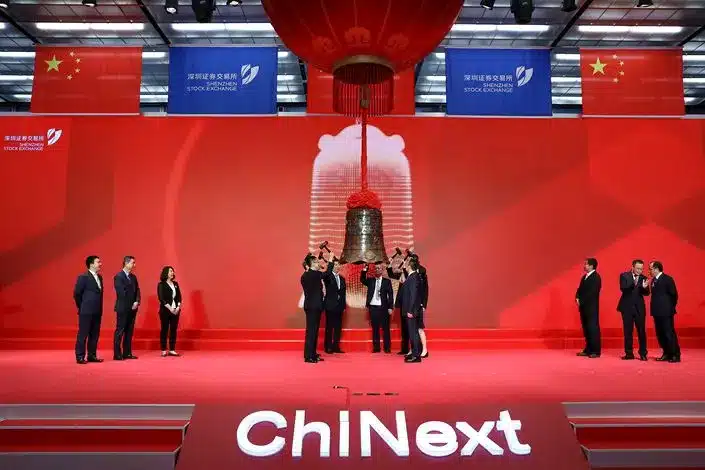
Image Credit: caixinglobal.com
ChiNext in 2020
To streamline the process of companies going public, ChiNex implemented a registration-based IPO system. This system maintains transparency and integrity in the market by requiring comprehensive evaluations, ensuring applicants are qualified for market entrance.
SZSE Component Index: Barometer of Market Performance
The SZSE Component Index is considered the primary indicator of market performance. Its purpose is to track the performance of a specific group of stocks representing the broader market as a whole. This group includes stocks from various sectors for the most accurate assessment.
The index is weighted by free-float adjusted market capitalization. This means that only shares that are currently available for public trading are used for calculation in the index. In contrast, with standard market capitalisation, both public and privately owned shares are considered.
Due to the shifting nature of the Shenzhen Stock Exchange, it’s important that the index be revisited regularly. The index is periodically reviewed and rebalanced to adjust for changes in market conditions. This ensures it remains an accurate and reliable representation of the market as a whole.
Navigating the Regulatory Landscape
The regulatory landscape of the Shenzhen Exchange is complex. It’s shaped by the combined influences of China Securities Regulatory Commission (CRSC) oversight and a growing emphasis on cross-border regulations. Additionally, recent years have brought a significant shift toward regulations aimed at improving transparency, including the IPOs mentioned above.
CSRC’s Role in Shaping the SZSE
The China Securities Regulatory Commission can be considered the backbone of the SZSE. The CSRC sets listing standards, and trading rules, while also regularly monitoring factors such as market prices. In other words, the CSRC’s influence on the Shenzhen Stock Exchange is significant.
For SZSE listed companies, the CSRC is responsible for regular compliance investigations. This practice is to ensure that all listed companies are complying with regulations and securities laws. Additionally, the CSRC is involved in introducing market reforms. The partnership between the SZSE and the CSRC was key to implementing the registration-based IPO system.
Here’s a more extensive look at the role of the CSRC in the Shenzhen Stock Exchange.
Recent Regulatory Reforms
The Shenzhen Stock Exchange is relatively young compared to many of the other major exchanges around the globe. As such, the SZSE has undergone a series of major regulatory reforms in recent years. The purpose of these reforms has been to increase corporate governance standards, streamline listing processes, and fuel investor confidence. The CSRC has been a critical player in all this.
One example, and also one of the most notable reforms, is the registration-based IPO System. This was key in removing unnecessary regulatory hurdles for companies wanting to go public. Reforms like this, and others, are important for improving the quality of listed companies on the SZSE.
It’s important to also not dismiss the CSRC’s role in risk management for investors. Through regulatory reform, the commission is able to address financial risks, including market manipulation. Regulation reform in recent years has focused on the monitoring of abnormal trading activity and enforcing penalties.
Cross-Border Regulations
International participation in the “Shenzhen Stock Exchange is influential on China’s economic health. However, in the past, there have been barriers to international participation. Today, China’s regulatory landscape has shifted to accommodate greater global participation in the SZSE.
Two of the important changes in cross-border regulations include the Qualified Foreign Institutional Investor and the RMB Qualified Foreign Investor Program. Additionally, Stock Connect programs and relaxed foreign ownership limits have also had an impact on the market.
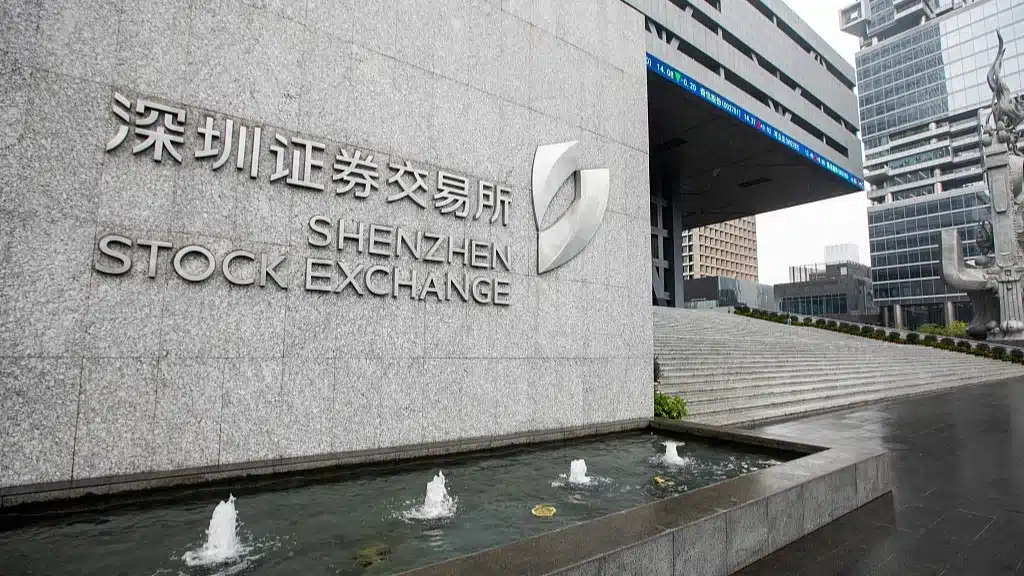
Image Credit: news.cgtn.com
Shenzen Stock Exchange sign in Guangdong Province in 2018.
First, let’s discuss the Qualified Foreign Institutional Investor (QFII) and RMB Qualified Foreign Institutional (RQFII) programs. In a nutshell, these programs increase foreign access to the SZSE and have increased foreign investment quotas.
Secondly, the Stock Connect Programs have been put into place to establish direct international trading links. For example, the Stock Connect Programs have established a trading link between Hong Kong and the SZSE on eligible shares.
Finally, it relaxed foreign ownership limits in certain sectors of the SZSE. For example, removing foreign restrictions on investments in the manufacturing sector.
Safeguarding Investors: Protection Mechanisms
The Shenzhen Stock Exchange, along with the CSRS, is diligent in implementing protections to safeguard investors and uphold market integrity. A robust risk management system is a key element of these protections. There is a strong focus on real-time monitoring of market activity and transactions. Advanced algorithms are used to flag trading activity that appears suspicious and issues are immediately addressed.
There have also been increased disclosure requirements. Companies listed on the SZSE are required to provide updates on their financial conditions. This includes any developments that could potentially impact the performance and price of their stocks. These regulatory initiatives have increased transparency and ensured all companies supply information on an equal scale.
Still, it’s not just the company side of things the SZSE has considered when safeguarding investors. There has also been greater focus on investor education and financial literacy programs. With access to educational programs and materials, investors are better able to understand risk and market dynamics.
Circuit Breakers and Trading Halts
Circuit breakers and trading halts are important for protecting investors and managing market volatility. They are tools that can be activated when prices or market movements push past predetermined thresholds. The intent is to provide a cooling-off period when the market is experiencing a high level of volatility.
Circuit breakers are triggered in response to price movements. These may be individual or market-wide movements that exceed thresholds. In this case, the circuit breaker is triggered and trading comes to a halt.
Circuit breakers aren’t the only reason for trading halts. They can also be implemented during times of unusual trading patterns, pending announcements, or other factors potentially affecting market volatility.
Both circuit breakers and trading halts create what is known as a cooling-off period. This prevents hasty or panic-driven trading when the market is experiencing excess stress.
Regulatory Body Responsibilities
Here’s a quick rundown of regulators and their key responsibilities.
Regulatory Body: CRSC
- Set listing standards for companies listed on the SZSE
- Oversee market reforms
- Ensure securities laws are enforced
Regulating Body: SZSE
- Monitory daily operations of the stock exchange
- Implement trading rules
- Ensure listed companies are in compliance with regulations
Regulating Body: Local Government
- Promote local and regional economic growth
- Support market development
- Local Government
Embracing the Future: Technological Advancements
The Shenzhen Stock Exchange has been committed to utilizing new, cutting-edge technology to enhance market operations. This includes tools such as advanced trading platforms to handle high-frequency, data analytics, and AI technology. Looking toward the future, blockchain technology is also being explored for managing settlement and clearing processes.
Next-Generation Trading Platforms
As the market changes, there’s a need for the SZSE to adapt with the help of advanced trading platforms. These technologically advanced systems allow for greater speed, reliability, and scalability in trading options. With the growing demand for high-speed trading, having systems in place to meet the demand is essential.
A key component of this is the low-latency trading systems. These perform exceptionally well for high-speed algorithmic trading. With algorithmic trading, there’s a need for reduced delays between order placement and execution. Low-latency trading systems are able to meet this need.
The adoption of cloud computing technologies has been another boost for SZSE. By being able to exchange massive volumes of transactions, these technologies support scalability. Cloud technologies also support the reliability of trading by providing uninterrupted service, regardless of the level of market activity. Along this line, mobile trading applications have enabled investors to access real-time market information.
AI and Big Data: Revolutionising Market Intelligence
There is significant potential in AI and big data for transforming how market intelligence is collected and used. Through AI the SZSE monitors large amounts of transactions to detect unusual trading patterns and possible market manipulation. The faster these patterns are identified, the faster regulators can act.
Big data analytics are also playing a role in revolutionizing market intelligence. Big data has the capability of analyzing massive amounts of market information. The Shenzhen Stock Exchange can then take this information to better understand current market dynamics.
Blockchain: Exploring New Frontiers
Moving toward the future, blockchain is a consideration for improving efficiency and transparency within the SZSE. Blockchain, by nature, is decentralized and creates an environment where the risk of fraud is reduced.
Another area of exploration for blockchain within the SZSE is creating tamper-proof records of ownership, further reducing the potential for tampering and fraud. Blockchain-based smart contracts are another area of exploration. Smart contracts could easily automate corporate actions like dividend distributions.
Innovation Roadmap: Pilot Projects and Future Plans
The SZSE is focused on innovation and is currently involved in pilot projects for testing new technologies. These types of pilot programs allow the SZSE to assess the feasibility and outcomes of new technologies in a safe, controlled environment. This is key for evaluating risks to the market before full implementation.
One example is SZSE’s collaborations with fintech companies and academic institutions to drive exchanges with new innovations. Quantum computing and cybersecurity are two focus areas for technological advancements.
Expanding Horizons: International Connectivity
The Shenzhen Stock Exchange has been instrumental in building China’s economy through initiatives that support greater international connectivity. Initiatives like Stock Connect programs, QFII, RQFII, and cross-border product listings have made foreign investment easier and more attractive.
Stock Connect: Bridging Markets
The Stock Connect program is a key component of the SZSE’s international connectivity strategy. In the most basic terms, Stock Connect allows global investors to trade mainland Chinese stocks through the Hong Kong Exchange (HKEX). The primary benefit has been to ease entry into China’s markets for foreign investors.
Through Stock Connect, the HKEX serves as an entry point to the Shenzhen market without needing direct market access. This program, on its own, has significantly increased the accessibility of companies listed on the SZSE to global investors. Stock Connect creates a great open door for institutional, retail, and tech investors to participate in China’s growing sectors.
While Stock Connect is critical for global accessibility, the need to manage capital flow still exists. Quota systems are in place to control the level of cross-border trading that takes place, reducing marketing volatility.
Future Connections: Expansion Plans
To protect future growth, the SZSE is always looking at how to further expand international connectivity. Current considerations involve the possibility of implementing new Stock Connect programs with other Asian financial centers to expand investment opportunities.
Another area of consideration is implementing cross-listing arrangements with international exchanges. This would enable companies that are listed on the Shenzhen Stock Exchange to list on foreign exchanges. In turn, companies from other exchanges could list on the SZSE.
Finally, efforts are underway to align its trading and settlement systems with international standards. This step is key to facilitating smoother, safer global transactions.
QFII and RQFII: Attracting Global Capital
The Qualified Foreign Institutional Investor (QFII) and the Renminbi Qualified Foreign Institutional Investor (RQFII) programs allow approved foreign institutions to invest directly in China’s domestic markets. This includes the range of China’s securities, including stock, bonds, and derivatives.
As mentioned earlier, recent reforms have expanded investment quotas and the range of eligible investors. These programs complement the Stock Connect program, by providing more direct channels to participation in the SZSE.
Sustainable Future: ESG and Responsible Investing on the SZSE
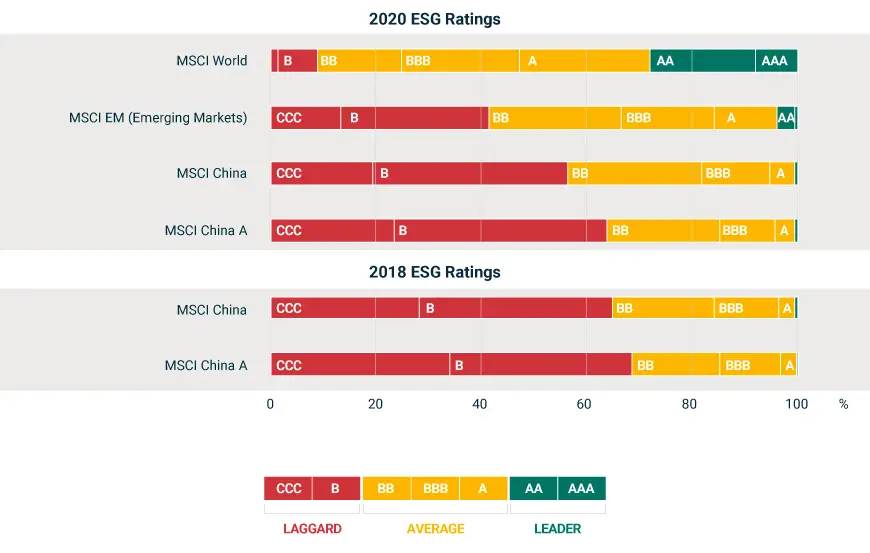
Image Credit: MSCI
China and the SZSE have a growing investment in ESG initiatives.
As part of an investment in the future, the Shenzhen Stock Exchange has introduced environmental, social, and government (ESG) guidelines. These are in place to encourage and support sustainable, responsible investing. With these guidelines, along with green finance and ESG investments, China is positioning itself for a more sustainable future.
Green Bonds: Financing a Sustainable Future
Green bonds are a financial tool that helps fund projects with environmental benefits. These can play an important role in helping China transition to a low or carbon-neutral economy. Sectors such as renewable energy, clean transportation, and pollution prevention are areas of interest.
The SZSE has established specific listing requirements and guidelines to ensure bond credibility, including meeting current environmental and sustainability standards. However, the SZSE is set up to provide guidance and support for companies seeking entrance into the green bond market.
ESG Reporting: Enhancing Corporate Transparency
Transparency is key to the health of the Shenzhen Stock Exchange, and this applies to the ESG reporting as well. The SZSE has a set of guidelines specifically for ESG reporting, indicating areas of focus. Companies are encouraged to address details such as environmental impact, and social responsibility in their annual reporting. This includes both qualitative and quantitative ESG data to allow investors to compare and make the most informed decisions.
Sustainable Investment Products: Meeting Investor Demand
In today’s market, the demand for sustainable investment products has expanded in China. This has created a need for the SZSE to meet investor demand, which is being accomplished through a few different measures.
First, there has been the launch of ESG-themed index funds and ETFs to track companies with strong ESG performance. Green mutual funds have also appeared for investment in companies that are committed to environmentally friendly and sustainable practices.
Additionally, impact investing products targeted at specific environmental outcomes are gaining momentum with the SZSE. In fact, in 2023, China issued the greenest bonds, outpacing both Germany and the United States.
Shaping Corporate Strategies: The ESG Influence
ESG principles have a growing influence on how companies operate, specifically in how to best appeal to investors. It has become important for listed companies to address ESG issues as part of their risk management strategy. For example, consider how climate change or governance issues may affect operations and profitability. Today, companies need to be aligned with global sustainability trends to retain profitability.
Investors are increasingly using ESG as an investment screen. They want to engage with companies that meet ESG criteria and demonstrate robust sustainability and ethical practices.
Pioneering New Frontiers: Market Innovations and Products
The Shenzhen Stock Exchange is focused on market innovation. They are accomplishing this through the introduction of new financial instruments and supporting emerging technologies. The goal is to provide investors with the broader investment options for portfolio diversification and enhanced risk management tools.
STAR Market Expansion: Boosting High-Tech Listings
The Shenzhen Stock Exchange is looking to launch a STAR-Market-like board, similar to the SSE’s successful STAR Market. This board would focus highly on companies in emerging tech sectors, such as AI, biotechnology, and advanced manufacturing. Compared to other boards, the STAR Market would have more flexible listing requirements. Ideally, this would appeal to tech companies with high growth potential and companies invested in research and development.
This new board would be instrumental in supporting the growth of high-tech firms in China. It would also help support the SZSE’s role in contributing to China’s tech innovation ambitions.
Eligibility Criteria: Nurturing Innovation
Eligibility requirements would likely be tailored to companies that demonstrate technological growth, tech advantage, and strong market potential. To accomplish this, the focus on financial thresholds would be less, making room to focus on R&D metrics instead.
However, while some eligibility requirements would be more lenient, others would not. For example, companies would be held to high governance and disclosure standards to protect investor interests.
Catalysing Innovation: Impact on the Ecosystem
With the development of a new board, the SZSE has considered the broader impact on the innovation ecosystem. Through the board, more venture capital and private equity could make their way to early-stage tech companies. This would provide critical funding and enable start-ups to scale.
This could also lead to enhanced research and foster commercialization of tech innovations, especially for research institutions and universities. The board would also promote greater collaboration in the tech industry. Collaborations between well-established companies, startups, and research facilities could really drive innovation in Shenzhen.
Derivatives Market: Expanding Risk Management Tools
The SZSE is expanding to include new options in its derivative market based on the market’s indices and individual stocks. With this, SZSE investors are offered new ways to hedge risks and speculate on price movements. There is also an exploration of commodity derivatives to support the real economy and manage issues from supply chain disruptions.
Index Futures and Options: Enhancing Market Efficiency
Index futures play a critical role in today’s financial market. They enable investors to manage risk while implementing more complex trading strategies. These products can enhance liquidity in cash markets, leading to more accurate prices in the market.
Risk Management Toolkit: Empowering Investors
The Shenzhen Stock Exchange is expanding the range of risk management tools currently available to investors. By doing this, they’re able to empower investors to manage risks and protect their portfolios.
A few ways the SZSE is accomplishing this are through single stock options, ETFs, and educational resources.
With single stock options, investors are able to more precisely hedge risks associated with specific stocks. ETFs offer a way to manage risk exposure for certain sectors. This makes it easier for investors to hedge risk on an industry-wide level. While these tools are key to managing risk, educational resources are equally critical. The SZSE offers educational resources to help investors better understand risk and how to manage it more effectively.
Global Ambitions: Market Internationalization Efforts
As mentioned, SZSE is invested in expanding investment channels that improve access for foreign investors. By expanding cross-border investment channels and aligning with global standards, the SZSE becomes prominent in the global financial market.
Cross-Border ETF Listings: Bridging Markets
Cross-border ETFs are one way the SZSE is connecting with global investors. Through cross-border ETFs, international investors can access SZSE-listed companies, minus the need for direct access to the Chinese market. These products are also essential for boosting global visibility and showcasing the strength of Chinese companies. However, the success of cross-border ETFs relies heavily on regulatory compliance between international exchanges and the SZSE.
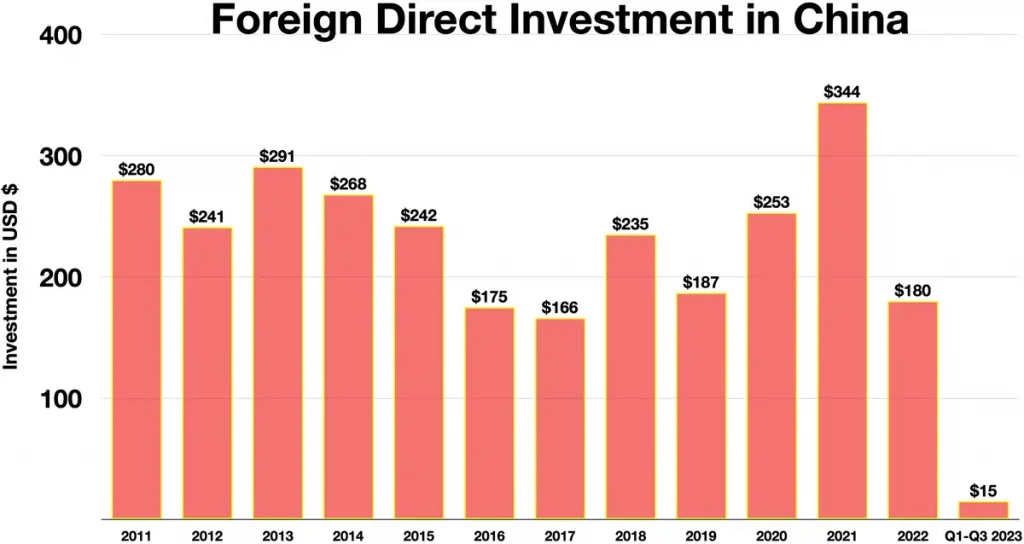
Image Credit: Wikimedia
Expanded international access is aimed at increasing foreign investment in China.
Regulatory Harmony: Facilitating Cross-Border Investments
With cross-border investments becoming more accessible through the SZSE, the need for regulatory harmony grows. Broad collaboration with international regulators is a must, both for the market and investors.
There are three primary ways the SZSE is facilitating cross-border investments.
- Memorandums of Understanding (MOUs): Signed with international regulators, MOUs enhance cross-border cooperation.
- Harmonizes Listing and Disclosure Standards: By adopting global standards for listing and disclosure practices, the SZSE makes it easier for investors to evaluate Chinese companies.
- Cross-Border Enforcement: This area is focused on investment protection. Through broader enforcement, legal challenges can be addressed more efficiently.
Global Outreach: Attracting International Investors
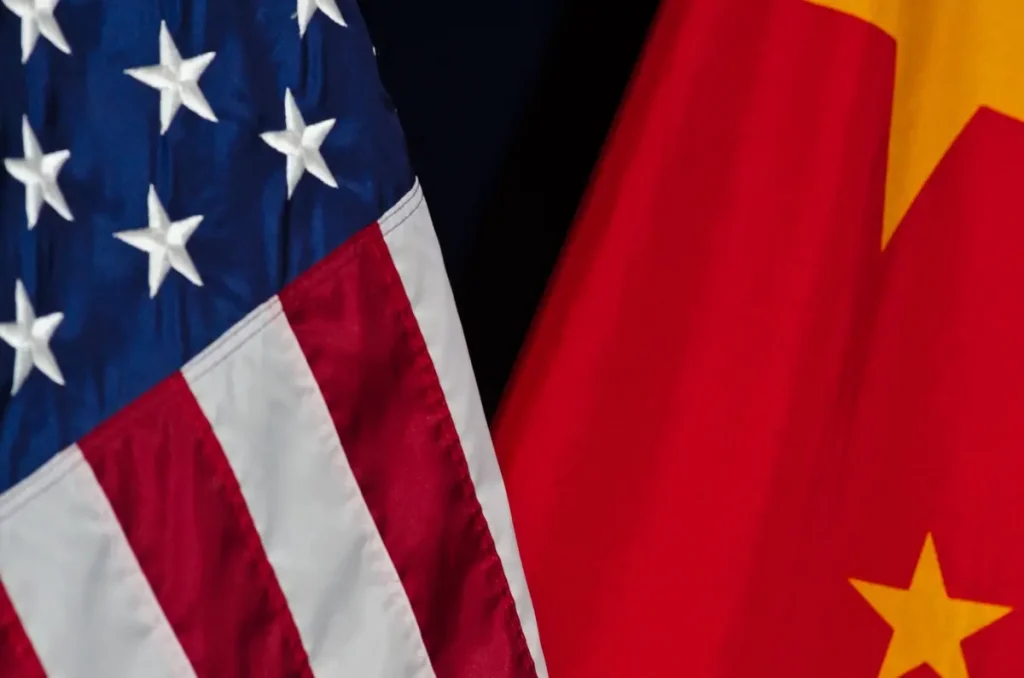
Image Credit: The Ticker
China is focused on expanding efforts to woo international investors
With global SZSE market expansion comes efforts to attract and motivate international investors. The SZSE has several ways in which they’re approaching this.
One means of attracting foreign investment has been through international roadshows and investor conferences. Taking place in the world’s leading financial hubs, these events are designed to highlight investment opportunities in SZSE-listed companies.
Moreover, SZSE is using digital platforms to its advantage. Through digital outreach, it becomes possible to seamlessly engage with international investors. Online webinars, virtual investor conferences, and broad-reach digital marketing campaigns are key to expanding SZSE global visibility.
Enhancing Communication: Investor Relations Improvements
Even in today’s age, communication barriers can present challenges for investor relations. This is why the Shenzhen Stock Exchange is dedicated to improving investor relations and communication practices.
As part of its efforts, the SZSE is increasingly encouraging listed companies to provide English versions of their financial reports and important investment-related communications. This seems like a simple step but it helps international investors establish trust and make informed decisions.
Additionally, SZSE-listed companies are taking the initiative to upgrade investor relations websites. Updated with timely reports, real-time updates, and advanced tools, keep international investors up-to-date.
Building Resilience: Market Stability and Risk Management
Risk management is a major component of market stability and risk management for the SZSE. Tools such as risk management systems, and stress protocols have been put into place to build resilience. Additionally, the SZSE has worked to strengthen its cybersecurity, protecting its trading platforms and investors. This has been in partnership with comprehensive crisis management protocols to swiftly handle market disruptions.
Stress Testing: Preparing for Market Shocks
Stress testing is a tool used to simulate extreme market conditions and evaluate the SZSE’s capacity to handle them. Stress tests can simulate a range of market disruptions, allowing the opportunity to evaluate their impact. When implemented effectively, stress testing helps predict potential vulnerability and form contingency plans. Currently, the SZSE collaborates on a broad scale with regulatory bodies and market participants in market-wide stress tests. With this level of collective approach, the effects of market stress can be assessed at every level.
Cybersecurity: Safeguarding Market Integrity
Cybersecurity is one of the major threats to the integrity of the SZSE and its participants today. With a heavy reliance on digital platforms, cybersecurity has been prioritized to safeguard trading platforms.
Examples of cybersecurity practices include advanced threat detection, security audits, assessments, and broader cybersecurity awareness programs.
Crisis Management: Preparing for the Unexpected
As mentioned, the goal of stress testing is to better predict and prepare for a market crisis. The other side is that the SZSE has a crisis management protocol. Swift and effective response during a market crisis is critical for mitigating risk.
The SZSE’s approach to crisis management includes having a dedicated crisis management team to handle unexpected market emergencies. This also included implementing detailed response protocols for a range of market disruptions.
Market Coordination: A Collaborative Approach
Market coordination among other exchanges is critical to ensuring board market stability. Market coordination allows for cross-market monitoring, allowing crisis management teams to act quickly in response to global market stress. Initiatives like information-sharing agreements, and coordinated circuit breakers are examples of the ways SZSE is invested in a collaborative approach.
Key Learnings and Future Outlook
As we recap, here are a few key points from our comprehensive overview of the Shenzhen Stock Exchange.
- The Shenzhen Stock Exchange was established in 1990 as a key platform for innovative tech and high-growth companies.
- Over the years, regulatory reforms and tech advancements have been instrumental in boosting market efficiency.
- The SZSE is advancing initiatives to expand international connectivity and attract global investors.
- In today’s investment climate, ESGs are changing the stock exchange landscape.
- Continual innovations and forward movement are helping the SZSE meet investor demands, both in China and around the globe.
- The SZSE is invested in proactive risk management strategies to better ensure market stability.
Key Statistics as of 2024
Total Listed Companies: Over 2,500
Market Capitalization: Approx. 35 trillion yuan
Average Daily Trading Volume: 800 billion yuan
Foreign Ownership: 5% of total market cap
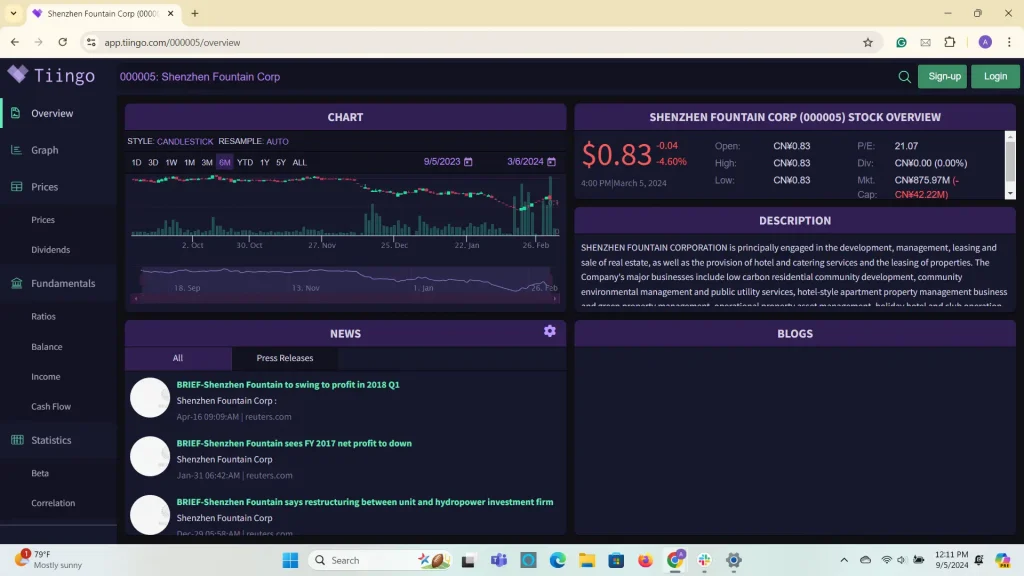
Image Credit: Tiingo
The Tiingo app provides coverage of global markets and robust data insights.
Looking forward, the Shenzhen Stock Exchange is a critical component in supporting China’s emerging tech and innovation industries. For global investors, having access to reliable information is key to navigating the SZSE with ease. At Tiingo, our comprehensive financial data services provide insights to SZSE-listed companies, allowing for informed investment decisions. Tiingo can help fuel your SZSE investment strategies. To learn more, check out our website, research our fundamental API, or contact one of our team members for consultation.
Leave a Reply